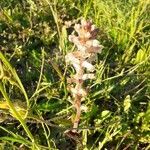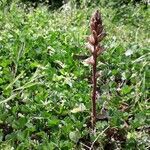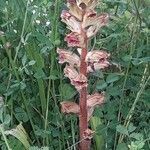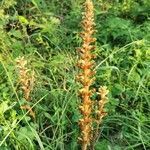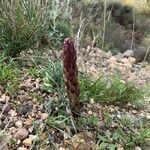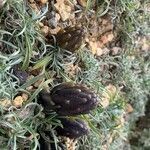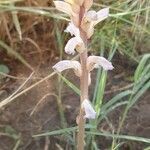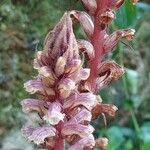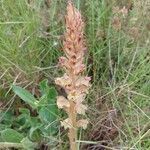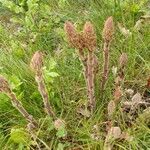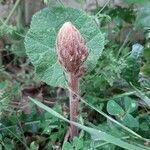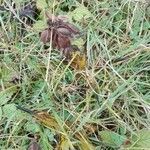Annual herb, holoparasite, 0.1-0.4 m high; stem yellow, simple, whole plant ± glandular-pilose. Leaves 5-17 x 2.0-4.5 mm, ovate to lanceolate, entire, apex acute. Inflorescence a terminal spike, laxly elongated at maturity; flowers dull yellow to violet-blue, sessile. Bracts leaf-like, long-acuminate. Calyx 5.5-11.0 mm long, Sub-Equally divided to base dorsally and ventrally in 2 segments, each segment ovate to ovate-lanceolate; teeth acuminate, entire. Corolla 10-18 mm long, with dark purple-blue venation; lobes rounded; upper lip emarginate, lower lip Sub-Equally divided into 3 lobes, central lobe smaller. Stamens inserted; filaments pubescent. Ovary with bilobed stigma.
Parasitic on many hosts, especially Trifolium; plants 1.5–5 dm, strict and simple from a ± bulbous-thickened base, ± glandular-villous; infl spicate, ± elongate, not very dense, especially below, the axis exposed; fls sessile, subtended by a bract but without bractlets; cal split to the base above and below, the 2 lateral segments slender and elongate, mostly bifurcate, commonly unequally so, the lower fork the smaller; cor white or yellowish, marked with violet, 10–15 mm; 2n=38. Native of Europe and w. Asia, intr. from N.J. to N.C.
A plant which keeps growing from year to year and which has erect annual shoots. It grows as a parasite living on the roots of clover or tobacco. It grows about 40 cm high. It has glandular hairs. They are brown or yellow. The scale leaves are oval or sword shaped and 1-2 cm long. The flower spike is dense. It becomes lax before flowering. The flowers do not have stalks. The fruit is a capsule 8-9 mm long. There are many seeds.
Yellowish, achlorophyllous, glandular-woolly root parasite to 40 cm. Leaves scale-like, imbricate at swollen base of stem. Flowers in a spike, dull brownish mauve and yellow, calyx split above and below, lobes thread-like.
